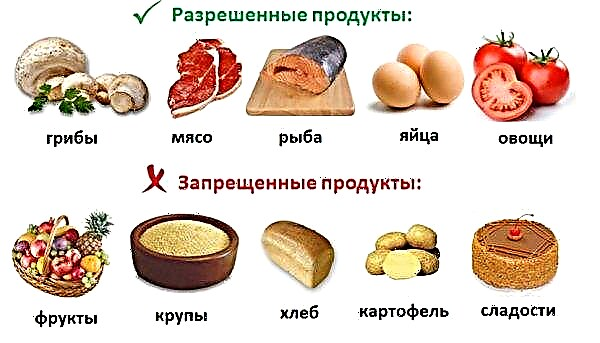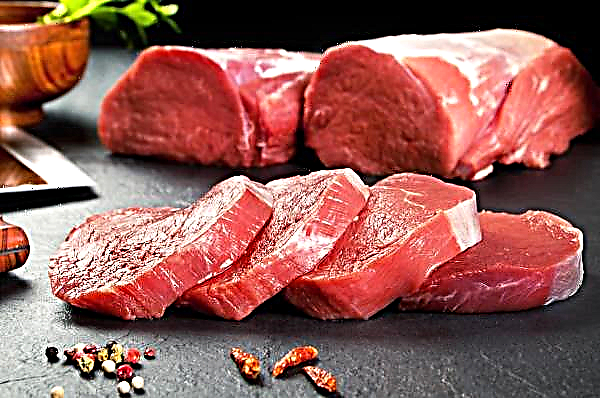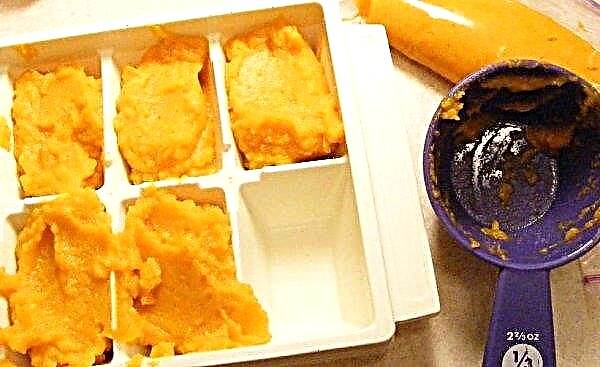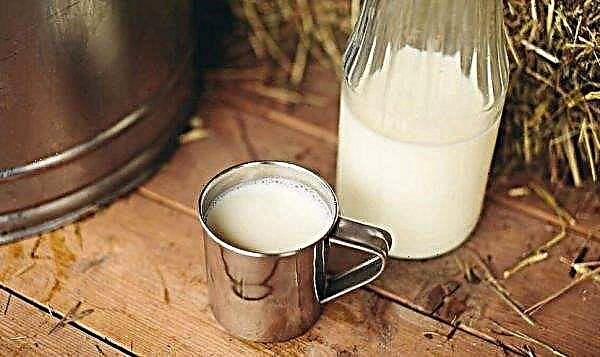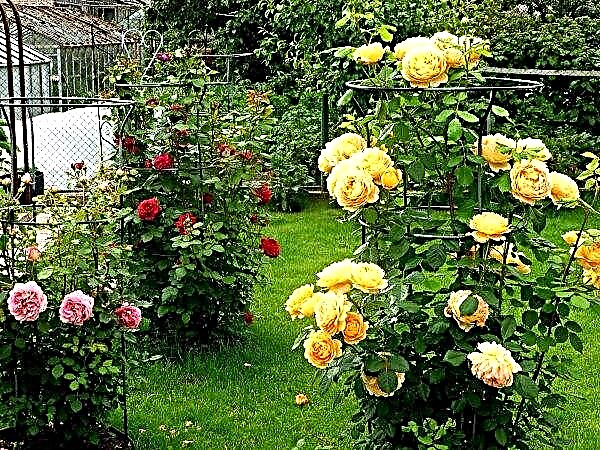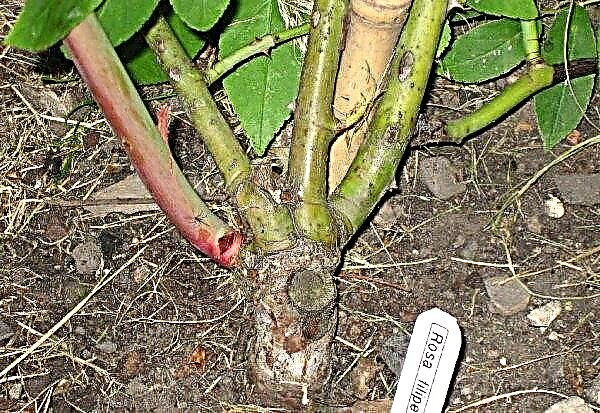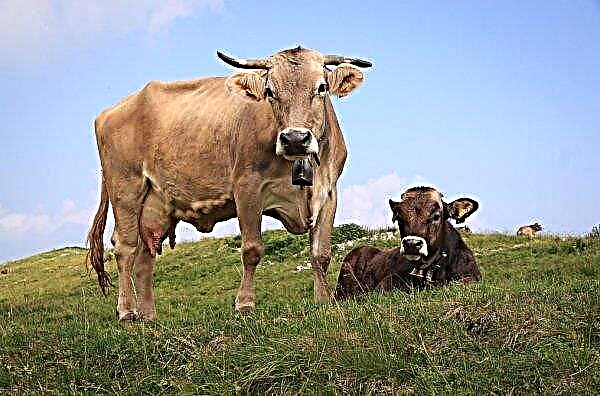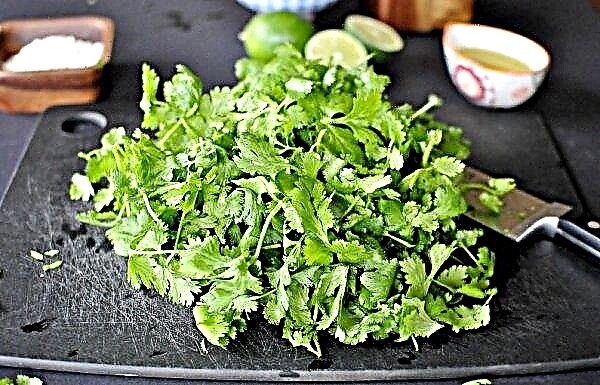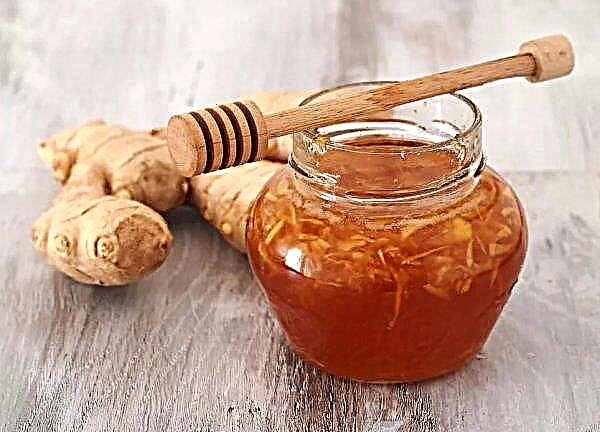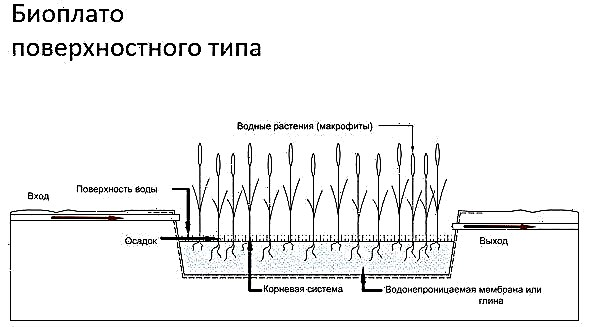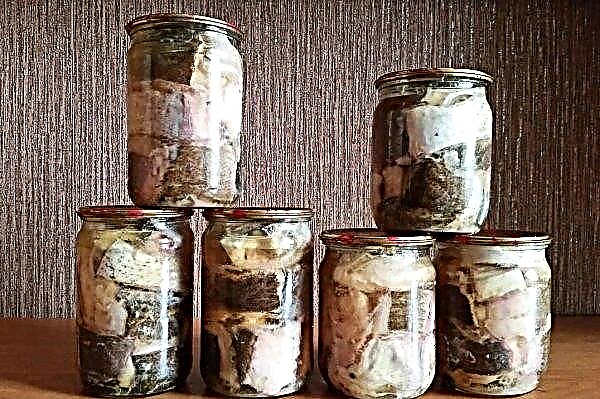Potato Nikulinsky has gained popularity among gardeners with a good balance of taste and disease resistance. You will learn about the characteristic features of the variety and the basics of its agricultural technology from this article.
History of origin of the variety
Potato Nikulinsky is a Russian variety obtained at the Moscow Research Institute of Potato Economy named after A. G. Lorch in the early 1990s by crossing the Mavka and Peresvet varieties. Already in 1996, he was included in the State Register.
Did you know? It is believed that the time of the ancient Incas was the time period that occupied the cooking of potatoes.
Description and characteristics of the variety
Nikulinsky belongs to the group of medium late potato varieties, whose growing season is in the range from 115 to 120 days.
Description of plant and fruit
The bush and tuber of this variety demonstrate such features:
- bush height - up to 80 cm;
- the sheet is elongated, jagged;
- upright stalk, many lateral branches;
- tuber weight - 70–135 g, on 1 bush - 8–12 pcs.;
- round tubers;
- peel of mesh texture, light, yellowish-beige color;
- the pulp is white, does not darken;
- small eyes, in large numbers;
- the taste is good, type boiled.
 Potato Nikulinsky is suitable for growing under various conditions and is not particularly demanding on soils.This table potato can be used for cooking, baking and preparing high-quality mashed potatoes. Tubers contain 16–21% starch, which is standard. Processing on flour, starch and dry mashed potatoes is possible. According to the register, the maximum yield indicator is 410 kg / ha, and marketable yield is from 170 to 294 kg / ha. Moreover, the authors of the variety promise from 310 to 450 kg / ha. At the same time, the plant achieves high productivity on fertile soil.
Potato Nikulinsky is suitable for growing under various conditions and is not particularly demanding on soils.This table potato can be used for cooking, baking and preparing high-quality mashed potatoes. Tubers contain 16–21% starch, which is standard. Processing on flour, starch and dry mashed potatoes is possible. According to the register, the maximum yield indicator is 410 kg / ha, and marketable yield is from 170 to 294 kg / ha. Moreover, the authors of the variety promise from 310 to 450 kg / ha. At the same time, the plant achieves high productivity on fertile soil.Important! Experienced gardeners recommend starting planting potatoes only after the opening of birch buds.
The stability of the culture allows you to get a sufficient mass of tubers even in the unfavorable season. The variety is resistant to cancer, but is affected by a black leg and a scab. The vegetable has an average susceptibility to late blight (the disease has a stronger effect on tubers), resistance to viruses, and immunity to the Y virus. Originators promise relative resistance to the Colorado potato beetle. Attractiveness to the variety is added by good marketability (71–95%) and excellent keeping quality (95%).
Advantages and disadvantages of the variety
- The described variety has the following advantages:
- stable productivity;
- good taste;
- unpretentiousness to growing conditions;
- excellent keeping quality.
- Sometimes among the disadvantages of the variety indicate:
- fresh taste and problems when growing in the rainy season.
Landing and care
To obtain the maximum productivity of the variety, it is necessary to plant tubers correctly and provide care for the plant throughout the entire growing season.
Landing time
The exact term of Nikulinsky’s landing varies depending on the climate of the region and the specific weather in the spring season. For germination, potatoes need a soil temperature of + 8 ... + 10 ° C at a depth of 10 cm. On average, such conditions occur in late April. When cultivating Nikulinsky potatoes, it is necessary to strictly observe the optimal planting dates, taking into account climatic conditions, to qualitatively prepare planting material
When cultivating Nikulinsky potatoes, it is necessary to strictly observe the optimal planting dates, taking into account climatic conditions, to qualitatively prepare planting material
However, for this culture is harmful not only too early landing, but delaying it. If the temperature in the soil rises to + 28 ° C, and at night the air does not cool below + 20 ° C, the laying of tubers is stopped.
Choosing a place and preparing the garden
The potato bed should be located on a sunny and dry area, where there is no cold gusty wind. Compliance with the principle of crop rotation is the prevention of various diseases:
- it is best to plant a crop after cabbage, pumpkin and legumes, garlic and onions;
- do not plant potatoes after solanaceous - tomatoes, peppers and eggplant.
A good crop can be obtained on any soil, but it is advisable to plant potatoes in fertile soil with an acidity of 5.1-6 pH. There are several ways to increase the fertility of a potato bed:
- during autumn digging, fertilizer should be applied to the depth of the shovel (7 kg of rotted manure, 35 g of superphosphate and 15 g of potassium sulfate are needed per 1 m²);
- sow in the autumn a row of green manure, whose seedlings after spring mowing should be planted 10 cm deep.
 Fertilization in the soil increases productivity by 1.5 times, without loss of preservation of root crops and table qualities of tubers
Fertilization in the soil increases productivity by 1.5 times, without loss of preservation of root crops and table qualities of tubersIt is also recommended that you further disinfect the soil using one of the following recipes:
- pre-spray (in autumn) soil with bleach (100-200 g per 1 m²);
- immediately before planting, spill the garden with formalin (1 cup of 40% solution per 10 l of water);
- during the planting of each tuber in the hole add 40-60 g of Iprodion.
Important! To protect the tubers from rot, it is recommended to dust them with lime, chalk or zeolite at the rate of 2 kg per 1 t.
Presowing treatment of tubers
To get strong seedlings and healthy plants, planting material must be carefully selected and subjected to special treatments. First of all, the potatoes are carefully sorted, and only fully healthy specimens are recognized as fit. Then germination is performed, which can be combined with the use of growth stimulants:
- place the tubers in a bright place at + 12 ... + 15 ° C and leave for 2–4 weeks;
- if there is no such time in stock, it is necessary to wait for the first shoots to appear, which will take about 5-6 days.
 After germination, sorting is repeated again, choosing tubers with the strongest sprouts. Now, planting material should be disinfected by dipping 1 kg of wood ash in a bucket of water (dissolve in 1 bucket of water), potassium permanganate solution, or using special preparations (Fitosporin, Prestige, etc., according to the instructions). Pre-planting cutting of tubers is widespread, as a result of which pieces of about 40 g are obtained, which should have the same number of eyes.
After germination, sorting is repeated again, choosing tubers with the strongest sprouts. Now, planting material should be disinfected by dipping 1 kg of wood ash in a bucket of water (dissolve in 1 bucket of water), potassium permanganate solution, or using special preparations (Fitosporin, Prestige, etc., according to the instructions). Pre-planting cutting of tubers is widespread, as a result of which pieces of about 40 g are obtained, which should have the same number of eyes. Completed sections must be treated with ash
Completed sections must be treated with ashTechnology and landing pattern
The optimal planting scheme is considered to be 25-30 × 60–70 cm, while the depth of planting will depend on the type of soil:
- on a bed with heavy soil, the tubers should go 5-7 cm underground;
- for light soils, a depth of 8–10 cm should be maintained.
 Potato planting scheme: a - in the usual way; b - by the ridge method. In the case of a close level of groundwater occurrence, landing by "ridges" can be used. In this case, the tubers need to be arranged in a row and pour a “comb” from the soil on top. For a similar situation, the “under the straw” method is also suitable, when instead of a layer of earth a high layer of straw is made (from 30 cm). As germination and compaction of the mulch are added to the straw.
Potato planting scheme: a - in the usual way; b - by the ridge method. In the case of a close level of groundwater occurrence, landing by "ridges" can be used. In this case, the tubers need to be arranged in a row and pour a “comb” from the soil on top. For a similar situation, the “under the straw” method is also suitable, when instead of a layer of earth a high layer of straw is made (from 30 cm). As germination and compaction of the mulch are added to the straw.Watering frequency
The plant should receive the first moisture as soon as the height of the shoots is 10 cm (if the soil is dry). Watering is necessary for potatoes when such signs appear:
- lightening and lethargy of foliage and stems;
- the dying off of small stems;
- the bush reduces the growth rate, and flower buds do not open.
With a lack of natural precipitation, especially on sandy soils, each plant will require at least 4 liters of water heated in the sun.
Overmoistening harms the culture, and its signs are:
- rotting of small tubers;
- the leaves on the bush darken, and then begin to fade;
- weeping spots and plaque form in the lower part of the stem.
Fertilizing and Hilling
If the bed is correctly prepared for planting in the fall or a mixture of fertilizers has been added to the hole for each tuber, additional feeding may not be necessary. Otherwise, you should use one of the proposed recipes:
- For root dressing, mix 1 part of potassium and phosphorus and 2 parts of nitrogen, and then dilute 25 g of the mixture in 10 l of water. You can take a urea solution (1 tbsp.spoon for every 10 liters of water, pour 0.5 l under 1 bush).
- For spraying, a humate solution (2 g per 10 l of water, based on 3 l of the mixture per 1 hundred square meters of land) or a mixture based on urea (100 g of urea, 150 g of monophosphate and 5 g of boric acid should be diluted in 5 l of water) is suitable. Processing the last mixture is carried out twice, and for the first time it must be diluted in half.
 Agrochemicals can be replaced with mullein, bird droppings and effective herbal infusions. Hooking is an agrotechnical technique that primarily helps to avoid the influence of spring return frosts on planted tubers. Its subsequent function is to strengthen the formation of tubers, as well as the destruction of a certain number of eggs of the Colorado potato beetle.
Agrochemicals can be replaced with mullein, bird droppings and effective herbal infusions. Hooking is an agrotechnical technique that primarily helps to avoid the influence of spring return frosts on planted tubers. Its subsequent function is to strengthen the formation of tubers, as well as the destruction of a certain number of eggs of the Colorado potato beetle. Repeated hilling should be done after the bush has grown to 20 cm, covering the plant at half height. In parallel with the earthing up, it is convenient to perform root top dressing.
Repeated hilling should be done after the bush has grown to 20 cm, covering the plant at half height. In parallel with the earthing up, it is convenient to perform root top dressing.Important! If the plant has been exposed to frost, then foliar top dressing should be delayed for 2-3 days.
Protection against diseases and pests
The first stage of plant protection is preplant planting. The most dangerous pests waiting for a potato bed during the growing season include:
- The Colorado potato beetle, the fight against which in a small cultivation area can be reduced to the collection and destruction of beetles and larvae. Spraying bushes with infusion of wormwood, celandine, bitter pepper, and other folk remedies can be effective. If over a large area there are already more than 5 larvae per bush, it is necessary to use insecticides.

- Wireworms and pseudowires affect stems and tubers. Crop rotation and early planting are considered the best prevention.

- The smallest worms of the stem nematode live in the soil and tubers, and the infected plants are indistinguishable from healthy plants. For protection, seed tubers should be carefully monitored, digging in the garden in the fall, and plant debris and weeds destroyed.

As mentioned above, the Nikulinsky variety is sensitive to late blight, which leads to rotting of tubers both during growth and during further storage. The disease is especially rampant in wet and warm weather. For prevention, you can use infusions according to popular recipes, antifungal mixtures, as well as high hilling. If the landing is infected with a Colorado potato beetle, you can prepare a tank mixture with the addition of insecticides in order to provide comprehensive protection for 1 treatment.
Did you know? When danger is detected, the Colorado beetles fall down and pretend to be dead.
To prevent infection of tubers with late blight and black leg, the tops should be mowed and removed from the plot 7-10 days before harvesting. This variety is susceptible to infection with scab, which forms on the skin of the tuber and causes growths similar to warts. It is possible to reduce the pathogenicity of the pathogen by feeding manganese sulfate (based on 6 g per 1 m²).
Harvesting and Storage
When digging up tubers, care should be taken not to damage them. The potatoes are dried for 3-4 hours in the open air in dry weather. If the days are rainy, they will arrange temporary shelter and dry the vegetables there for 2-3 weeks. Then the crop should be sorted out and the best quality potatoes removed for long-term storage.
Storage takes place at a temperature of + 1 ... + 5 ° C and an air humidity of 85–90%, and the room must be equipped with exhaust ventilation. Potatoes can be stored in bags made of natural materials that will allow air to pass through, or in wooden boxes. Often, the crop is simply folded in a slide on the floor, always leaving free space to the ceiling (at least 0.5 m). So, the Nikulinsky potato variety is suitable for cultivation on household plots and on farms in most regions. This vegetable combines unpretentiousness to growing conditions and good commercial qualities.
So, the Nikulinsky potato variety is suitable for cultivation on household plots and on farms in most regions. This vegetable combines unpretentiousness to growing conditions and good commercial qualities.




